#fadenia
Text
On Helicoprion's Pelvic Fins (or lack thereof)
For about a year, now, I've been wracking my mind on the subject of the latest reconstruction of the extinct holocephalan[1] Helicoprion[2]. By all other accounts the latest reconstruction, which can be viewed below, is the best it's ever been. The iconic Eugeneodontid[3] tooth whorl fits into the jaw in a logical way and lends credence to our present understanding of its diet.
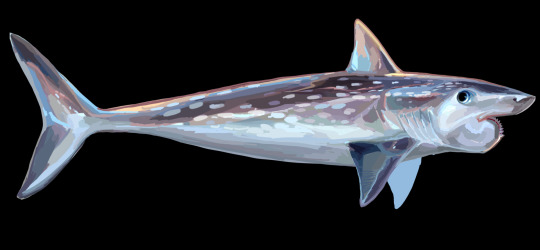
But, as you gaze further posterior, you may notice something queer: no pelvic or anal fins. Now, a not-insignificant number of living chondrichthyes[4] lack anal fins. This is not out of the realm of imagination. But the same cannot be said of the pelvic fins, which aid in control and stabilization and also serve as the girdle for which claspers are attached to in males. All living chondrichthyes possess pelvic fins; from chimaeras like Hydrolagus colliei[5], to sharks like Hexanchus griseus[6], to skates[7] like Raja binoculata[8].
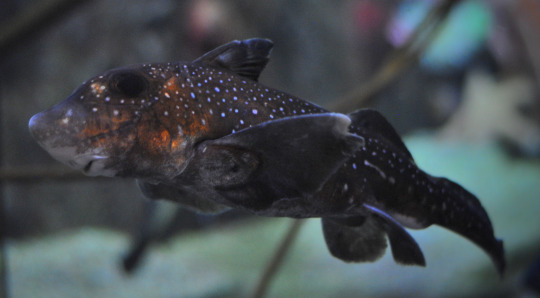
(Hydrolagus colliei)
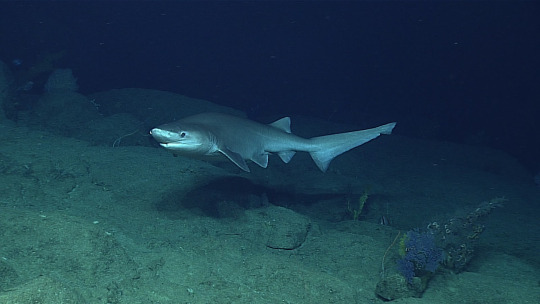
(Hexanchus griseus)

(Raja binoculata)
So, why are they missing in our latest reconstruction? I made attempts last year to reach out to the researcher responsible for our modern understanding of Helicoprion, Jesse Pruitt (whose lecture on his research set me off on this journey), through LinkedIn, but I never got a response. Looking through my message history, though, the conversation appears to have disappeared, making me wonder if I'd actually sent it at all.
This morning, I tried again. I drafted up my question and reasoning and sent it to Pruitt's LinkedIn and ResearchGate profiles, and I sent it to the Idaho Visualization Laboratory (IVL) which made the Helicoprion model. I had expected considerable delay, but to my mirth, I got a response this afternoon.
On behalf of IVL, Leif Tapanila responded to my email with answers. As it were, other Eugeneodontids from the Carboniferous and Permian periods were preserved better than our Helicoprion specimens. Specimens of Fadenia[9] and Romerodus[10] were preserved very well with full-body imprints in consistent shale rock.

(Fadenia)

(Romerodus)
These imprints lack pelvic fins. Considering their close relation to Helicoprion, this absence was assumed for the visualization. I've inquired after Edestus[11], another Eugeneodontid of the same era, since there are many specimens and imprints, however fragmentary. I have yet to receive an answer, but when I do, I will update this post.

(Edestus)
I was determined to find some oversight, since holocephalan specimens from the Devonian period include pelvic fins in their reconstruction, but it seems the facts have dissolved my suspicions. I wanted to share this with you all, since I cannot edit Wikipedia articles (much to my dismay, as I have learned much and more in my studies of H. griseus that I want to add to its page). This knowledge deserves to be shared, since I find it ponderous.
Until next time,
[1] Subclass of chondrichthyes, containing contemporary chimaeras.
[2] Extinct eugeneodontid. Etymology translates to "Spiral saw"
[3] Order of holocephalan characterized by tooth "whorls" and inability to shed teeth.
[4] Class of chordate (vertebrate) characterized by a cartilaginous skeleton
[5] Chimaera known as the "spotted ratfish"
[6] Hexanchiform known as "bluntnose sixgill shark"
[7] Order of elasmobranch "Rajiformes," adjacent to rays.
[8] Rajiform known as "big skate" (no, really. haha)
[9] Eugeneodontid from the Carboniferous, Permian, and Triassic period
[10] Eugeneodontid from the Carboniferous period
[11] Eugeneodontid from the Carboniferous period characterized by its scissor-like teeth and jaws.
#helicoprion#edestus#romerodus#fadenia#holocephalan#chimaera#chimera#chondrichthyes#eugeneodontida#jesse pruitt#idaho state university#idaho visualization laborator#ivs#paleontology#marine biology#fish
91 notes
·
View notes
Text
Moa Monday
Tully Monster Tuesday
Woolly Mammoth Wednesday
Thylacine Thursday
Fadenia Friday
Sachicasaurus Saturday
Sacabambaspis Sunday
0 notes
Text
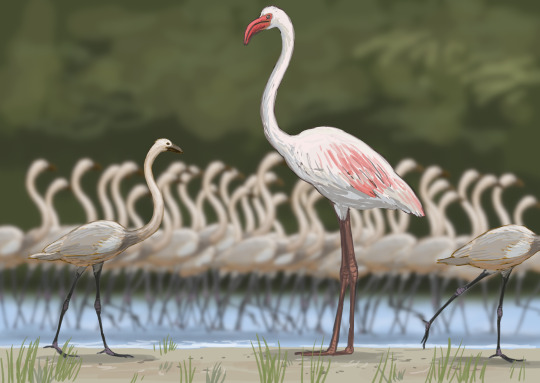
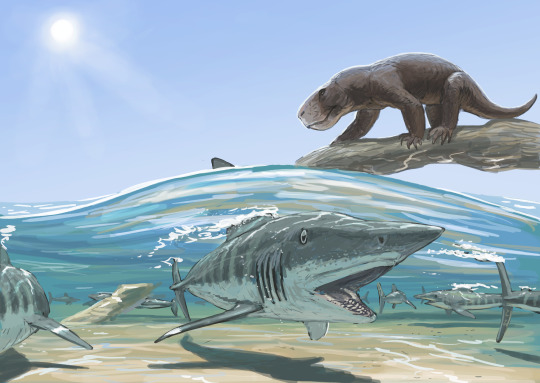
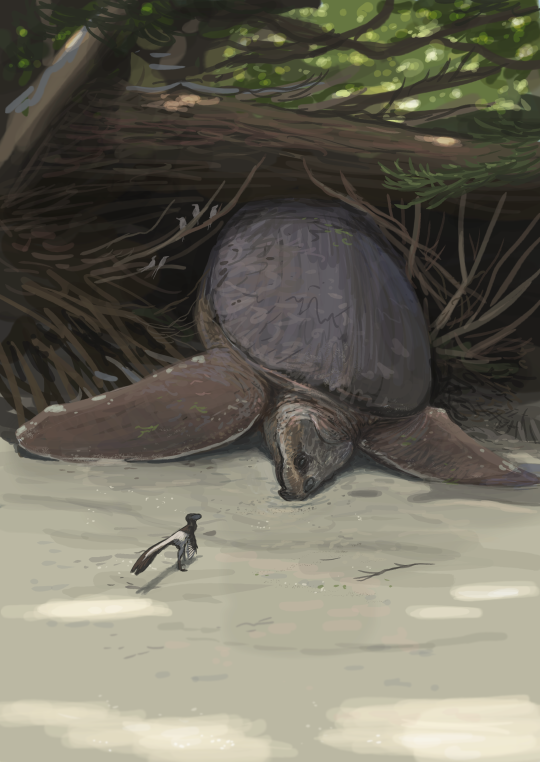
Results from the #paleostream!
Palaelodus and Harrisonavis; Fadenia and Aelurognathus; and Archelon.
2K notes
·
View notes
Note
🦖🙃 :]
HELICOPRION & FADENIA!!!! SILLY LIL SHARK ANCESTORS <- oversimplification
and while ive got them on the brain my "weird" fact is that current research suggests the unusual 'spiral' jaw of helicoprions was used to eat mollusks and soft-bodied animals, with the front teeth pulling prey into the mouth, the middle spearing it, and the hind teeth moving it to the throat where it would have been crushed and swallowed
1 note
·
View note
Photo

Weird Heads Month #11: Scissor-Toothed "Sharks"
The eugeneodontidans were a group of cartilaginous fish which convergently evolved to resemble sharks but were much closer related to modern chimaeras. Due to their cartilage skeletons usually little more than their teeth are found as fossils, and for a long time their ecology and life appearance has been poorly understood because of just how weird those teeth were.
These fish had unique "tooth whorls" in their lower jaws, and the most famous member of the group is probably Helicoprion, with the exact anatomical placement of its buzzsaw-whorl only being properly figured out in 2013.
But another eugeneodontidan named Edestus was equally strange.
Living during the late Carboniferous, about 306-299 million years ago, Edestus giganteus was the largest species in the genus, reaching estimated lengths of up to 6m (19'8"), similar in size to a modern orca or a particularly large white shark.
Let's take a closer peek at that mouth.
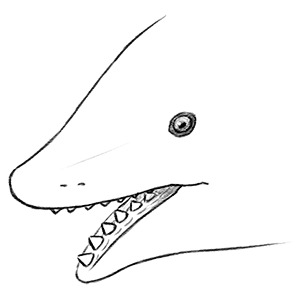
Yes, that's a single central row of teeth in both its upper and lower jaws.
Edestus' whorls grew in curving "banana-shaped" brackets that resembled an enormous pair of pinking shears, with new teeth being added on at the back and the oldest teeth occasionally being ejected off from the front. How this jaw arrangement worked was a longstanding paleontological mystery, with various bizarre ideas being proposed over the years – until a particularly well-preserved skull was analyzed in early 2019, revealing a two-jointed system in its lower jaw that allowed it to move its tooth brackets quickly back and forth, using a "snap-and-slice" motion to grab hold of prey like fish and soft-bodied cephalopods and cut them in half.
Along with body impressions from other related eugeneodontidans like Fadenia, showing a shark-like tail and a complete lack of rear fins, we now have a much better picture of what this bizarre fish probably looked like.

———
Nix Illustration | Tumblr | Pillowfort | Twitter | Patreon
#weird heads 2020#science illustration#paleontology#paleoart#palaeoblr#edestus#edestidae#eugeneodontida#holocephali#chondrichthyes#cartilaginous fish#fish#art#probably much more accurate than my last attempt at edestus#it's just a slightly weird shark rather than an ugly chimaera now#go home evolution you're drunk
463 notes
·
View notes